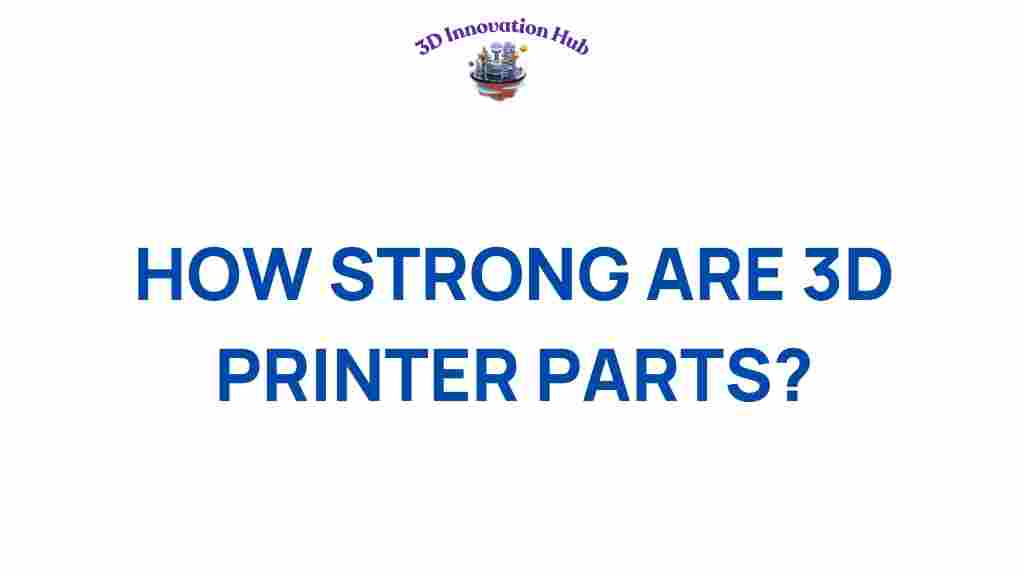Unveiling the Strength of 3D Printer Parts: What You Need to Know
In recent years, the world of manufacturing has undergone a revolutionary transformation, primarily driven by the advancement of 3D printer parts and additive manufacturing. As industries increasingly rely on these innovative technologies, understanding the key attributes of 3D printer parts—especially their strength and durability—has become essential for engineers and manufacturers alike. This article delves into the material properties, performance, and engineering considerations of 3D printer parts, providing you with the knowledge needed to harness the full potential of this technology.
Understanding the Strength of 3D Printer Parts
The strength of 3D printer parts can be defined as their ability to withstand applied loads without failure. This characteristic is critical in ensuring that printed components perform effectively in their intended applications. Several factors influence the strength and durability of 3D printer parts, including:
- Material Properties: The type of material used in printing plays a significant role in determining the strength of the final product.
- Print Settings: Parameters such as layer height, infill density, and print speed can impact the mechanical properties of the printed part.
- Post-Processing: Techniques like annealing, curing, and surface finishing can enhance the strength and performance of 3D printer parts.
Material Properties That Enhance Strength
When it comes to 3D printer parts, the choice of material is pivotal. Here are some commonly used materials along with their properties:
- PLA (Polylactic Acid): While easy to print and environmentally friendly, PLA has lower strength compared to other materials. It is suitable for prototypes and low-stress applications.
- ABS (Acrylonitrile Butadiene Styrene): Known for its toughness and impact resistance, ABS is often used in functional prototypes and end-use parts.
- PETG (Polyethylene Terephthalate Glycol): Combining the strength of ABS and the ease of PLA, PETG offers excellent durability and chemical resistance.
- Nylon: Renowned for its exceptional strength and flexibility, nylon is ideal for applications requiring high durability.
- Composite Materials: Materials like carbon fiber or glass fiber-infused filaments provide enhanced strength and rigidity, making them perfect for engineering applications.
Engineering Considerations for 3D Printer Parts
Engineering plays a crucial role in the performance of 3D printer parts. Understanding how design choices affect strength can significantly enhance the quality of the final product. Here are some key engineering considerations:
Design for Strength
When designing a part for 3D printing, consider the following:
- Geometry: Complex geometries can lead to weak points. Optimize the shape to distribute stress evenly.
- Infill Patterns: The infill density and pattern can dramatically influence the strength. For example, a honeycomb pattern provides good strength-to-weight ratio.
- Layer Orientation: The orientation of layers during printing affects inter-layer adhesion. Parts printed with layers aligned with the load direction typically exhibit higher strength.
Choosing the Right Technology
Different additive manufacturing technologies produce 3D printer parts with varying strengths:
- FDM (Fused Deposition Modeling): Commonly used for thermoplastics, FDM offers good strength but typically has limitations compared to other technologies.
- SLA (Stereolithography): Produces highly detailed parts with excellent mechanical properties, making it suitable for functional prototypes.
- SLS (Selective Laser Sintering): Uses powdered materials to create strong and durable parts, ideal for end-use applications.
Step-by-Step Guide to Enhancing Strength and Durability
To ensure your 3D printer parts exhibit optimal strength and durability, follow these steps:
Step 1: Select the Right Material
Choose a material that meets the specific requirements of your application. Consider factors such as load-bearing capacity, environmental conditions, and desired finish.
Step 2: Optimize Print Settings
Adjust your printer settings to enhance strength:
- Increase the infill density for parts that require higher strength.
- Choose a lower layer height to improve layer adhesion.
- Experiment with different print speeds to find the optimal balance between quality and time.
Step 3: Design for Performance
Incorporate design strategies that enhance strength:
- Utilize fillets and chamfers to reduce stress concentrations.
- Implement ribbing or bracing in high-stress areas.
Step 4: Utilize Post-Processing Techniques
Enhance the properties of your 3D printer parts through post-processing:
- Annealing: Heat treating your parts can relieve internal stresses and improve strength.
- Coating: Applying a protective coating can enhance durability and resistance to wear.
Troubleshooting Common Issues with 3D Printer Parts
Even with the right materials and settings, issues can arise during the printing process. Here are some common problems and their solutions:
Weak Layer Adhesion
If you notice that layers are not bonding well, consider:
- Increasing the print temperature.
- Reducing print speed to allow better fusion between layers.
Brittle Parts
Brittleness can be a sign of improper material selection. To address this issue:
- Ensure you are using the correct filament type for your application.
- Consider using a material with better ductility, like nylon.
Warping and Deformation
To prevent warping during printing:
- Use a heated print bed to maintain consistent temperature.
- Apply adhesives or use a brim to keep parts adhered to the bed.
Conclusion: The Future of 3D Printer Parts
The world of 3D printer parts is rapidly evolving, driven by technological advancements and innovations in material science. As industries continue to explore the capabilities of additive manufacturing, understanding the strength and durability of these components becomes crucial for success. By leveraging the right materials, optimizing design, and embracing engineering best practices, you can ensure that your 3D printer parts not only meet but exceed performance expectations.
For more insights into the latest trends in 3D printing technology, visit this resource. If you’re ready to dive deeper into the world of engineering and material properties, check out this article that explores the science behind 3D printing.
This article is in the category and created by 3D Innovation Hub Team
